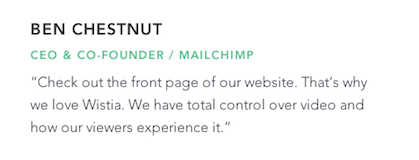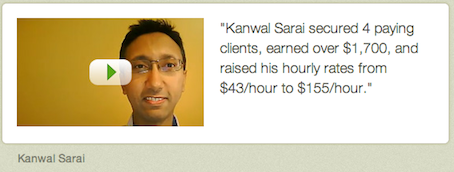It pays to sharpen your sales and marketing skills online.
These skills help you present your product or service to prospects in a way that persuades them to act. They let you paint a picture of just how different (and better) people’s lives would be if they bought what you’re selling.
But there’s something that not even the sharpest sales and marketing skills in the world can compete with in terms of raw persuasive power: testimonials from satisfied customers.
Most Websites Have a Credibility Problem
People won’t give you the benefit of the doubt online.
They’ll pay attention if you present your sales message in a certain way, but that doesn’t mean they’ll trustyou. There are too many scammers online trying to get them to open their wallets for inferior (or nonexistent) products or services.
On its own, a convincing sales message will get your prospects thinking, but it will only convince the most impulsive types to buy.
You need to inject credibility into your sales message to overcome people’s skepticism. Using your past customers’ own words is a great way to do it.
Bad Testimonials Can Backfire
Social proof, the psychological phenomenon where people modify their actions to match popular behavior, is a powerful credibility trigger.
Most businesses understand the importance of this online, but they do a poor job of leveraging it with their testimonials. They either don’t use them, or they use them ineffectively.
Poorly executed testimonials can be worse than having no testimonials at all. They can damage your credibility and stop interested prospects from doing business with you.
The Roadmap to Better Testimonials
Testimonials are great tools to boost your credibility and take advantage of social proof, but only if you know how to use them strategically.
Here’s how to do it:
Picking the Right Testimonials
The first and most important step of using testimonials effectively is selection.
Even if you do everything else right, if you don’t pick the right testimonials, you’ll have a hard time building your credibility and resonating with prospects.
So, what do you need to know about picking the right ones?
Make It Real
Fake testimonials are not a good idea. No matter how much that guy selling them on Fiverr tries to convince you otherwise.
It’s almost impossible to make a false testimonial sound authentic. And there’s always the potential of someone finding out and creating a public relations nightmare. This could get you into trouble with consumer protection agencies like the FTC.
The potential upside of doing this doesn’t even come close to the enormous risks.
Choose the Right People
You might have the impression you should focus on getting testimonials from your most well known or “high profile” customers. That’s not always the case; great testimonial selection comes down to: 1) understanding your target market; and 2) picking past customers who are representative of it.
If your target markets are mostly small business owners, focus on collecting testimonials from small business owners. Don’t get “star struck” with high-profile customers.
You could also choose a mixture of your ideal customers and a few high-profile ones. That’s what Neil Patel did over at Quicksprout.
What Makes a Testimonial “Good”?
Once you have a few customers in mind for testimonials, it’s time to turn to the language of the testimonials themselves to figure out if they’re any good.
What makes one testimonial better than the other? Here are a few things to keep in mind when assessing the quality of potential testimonials:
They Use Language That Describes Specific Benefits of Your Product/Service
“Impressed with their services.” “High quality product.” You’ve probably seen plenty of testimonials like these online.
They don’t do a thing to help you. Testimonials with general praising language don’t stand out, don’t separate you from your competitors in a meaningful way, and don’t do anything to help your credibility.
High-quality testimonials, on the other hand, use specific language to describe salient benefits of your product or service. Here’s how iCracked does it:

Use testimonials that point out selling features you want your prospects to hear about. They’re more convincing when they come from the mouths of your previous customers.
They Overcome Common Objections
Jot down a few of the few most common reasons why someone wouldn’t buy your product or service. Is it expensive? Does it require a substantial time commitment? Does it sound too good to be true?
Focus on using testimonials that reassure prospects and overcome these common objections. For example, if price is a major sticking point, you could use a testimonial raving about how your product is “worth every penny and more.”
Here’s how Studiopress addresses a common customer objection (customization) regarding premium WordPress themes:

They Are Longer Than a Few Words and Use Authentic Language
You might be tempted to cut down your testimonials to a few words and polish the language to make it sound more “professional.” Resist the urge!
Great testimonials use specific language, but that doesn’t mean they need to be a specific number of words. If your testimonial is only two or three words, you raise questions in your prospects’ minds about your credibility; they might think you took something out of context and wonder what the rest says.
Give your testimonials the length they need to tell a compelling success story. Don’t edit or polish the language.
Check out how Wistia did this on their homepage. The authenticity in the testimonial just bleeds through the screen:

They Describe Specific, Measurable Results
Which of the following sounds more convincing: “increased our revenue” or “increased our revenue by 35% in three months without increasing our expenses”?
It’s no contest: specific language trumps general language. Focus on testimonials that don’t spare any of the juicy details because it’s these juicy details that prospects love to hear. Take a look at this testimonial from Ramit Sethi’s site:

This type of language separates you from your competitors in a meaningful way and gives your prospects an idea about tangible results they can expect from you.
They Include Customer Photos
Adding customer photos is a great way to add a human element to your testimonials; they’re more than just words on a computer screen. They’re customers who were happy enough with your business to want to endorse you publicly. This makes an enormous impact on prospects browsing your website and considering a purchase.
They Use Customers’ Personal Information
Ever seen a testimonial from “R.J.” or “R. Johnson?” These kinds of testimonials scream fake. They do your credibility more harm than good, and they make your prospects run for the hills.
Quality testimonials include customers’ full names, websites, and/or locations. They show your prospects they’re coming from real people, and this makes them more convincing.
If you can’t get your customer to agree to use their full name in endorsing you, you’re better off waiting for a testimonial from someone who will.
Displaying Testimonials on Your Website
A lot of businesses stick to displaying their testimonials on their homepage and sales pages. This is a great starting point, but there’s no reason why you can’t use testimonials on other pages as well.
Consider points on your site where a prospective customer would be on the verge of a 1) buying decision or 2) an intermediate decision that gets them closer to a buying decision. These are great areas to use supporting language from satisfied customers.
Neil Patel increased his conversion rate by 7% percent by adding testimonials to his check out page. Derek Halpern uses a testimonial to encourage visitors to opt-in to his email list.
You are only limited by your imagination with this, and you can test to see how well displaying testimonials in different areas pays off.
Turn Happy Customers Into Salespeople
A crowd of happy customers is the best sales team your business could ever have. There’s no better way to bolster your credibility in the scammer-infested online space.
With the basics of testimonial selection, techniques and placement under your belt, you can leverage satisfied customers to wow your prospects and persuade them you’re someone they should do business with.
What do you think makes a testimonial great? Leave us a comment below and let us know!

Corey Pemberton is a copywriter and marketer who helps businesses get more traffic and conversions online. He loves travel, fitness, live music, and anything and everything outdoors. You can find him on his website or follow him on Twitter.






